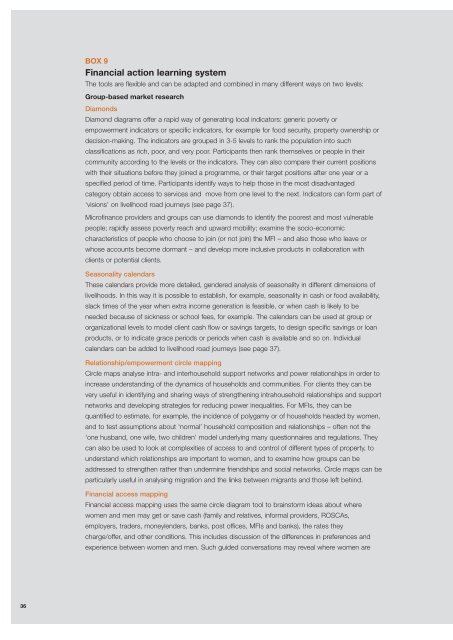Reaching and empowering women - Genfinance
Reaching and empowering women - Genfinance
Reaching and empowering women - Genfinance
Create successful ePaper yourself
Turn your PDF publications into a flip-book with our unique Google optimized e-Paper software.
BOX 9<br />
Financial action learning system<br />
The tools are flexible <strong>and</strong> can be adapted <strong>and</strong> combined in many different ways on two levels:<br />
Group-based market research<br />
Diamonds<br />
Diamond diagrams offer a rapid way of generating local indicators: generic poverty or<br />
empowerment indicators or specific indicators, for example for food security, property ownership or<br />
decision-making. The indicators are grouped in 3-5 levels to rank the population into such<br />
classifications as rich, poor, <strong>and</strong> very poor. Participants then rank themselves or people in their<br />
community according to the levels or the indicators. They can also compare their current positions<br />
with their situations before they joined a programme, or their target positions after one year or a<br />
specified period of time. Participants identify ways to help those in the most disadvantaged<br />
category obtain access to services <strong>and</strong> move from one level to the next. Indicators can form part of<br />
‘visions’ on livelihood road journeys (see page 37).<br />
Microfinance providers <strong>and</strong> groups can use diamonds to identify the poorest <strong>and</strong> most vulnerable<br />
people; rapidly assess poverty reach <strong>and</strong> upward mobility; examine the socio-economic<br />
characteristics of people who choose to join (or not join) the MFI – <strong>and</strong> also those who leave or<br />
whose accounts become dormant – <strong>and</strong> develop more inclusive products in collaboration with<br />
clients or potential clients.<br />
Seasonality calendars<br />
These calendars provide more detailed, gendered analysis of seasonality in different dimensions of<br />
livelihoods. In this way it is possible to establish, for example, seasonality in cash or food availability,<br />
slack times of the year when extra income generation is feasible, or when cash is likely to be<br />
needed because of sickness or school fees, for example. The calendars can be used at group or<br />
organizational levels to model client cash flow or savings targets, to design specific savings or loan<br />
products, or to indicate grace periods or periods when cash is available <strong>and</strong> so on. Individual<br />
calendars can be added to livelihood road journeys (see page 37).<br />
Relationship/empowerment circle mapping<br />
Circle maps analyse intra- <strong>and</strong> interhousehold support networks <strong>and</strong> power relationships in order to<br />
increase underst<strong>and</strong>ing of the dynamics of households <strong>and</strong> communities. For clients they can be<br />
very useful in identifying <strong>and</strong> sharing ways of strengthening intrahousehold relationships <strong>and</strong> support<br />
networks <strong>and</strong> developing strategies for reducing power inequalities. For MFIs, they can be<br />
quantified to estimate, for example, the incidence of polygamy or of households headed by <strong>women</strong>,<br />
<strong>and</strong> to test assumptions about ‘normal’ household composition <strong>and</strong> relationships – often not the<br />
‘one husb<strong>and</strong>, one wife, two children’ model underlying many questionnaires <strong>and</strong> regulations. They<br />
can also be used to look at complexities of access to <strong>and</strong> control of different types of property, to<br />
underst<strong>and</strong> which relationships are important to <strong>women</strong>, <strong>and</strong> to examine how groups can be<br />
addressed to strengthen rather than undermine friendships <strong>and</strong> social networks. Circle maps can be<br />
particularly useful in analysing migration <strong>and</strong> the links between migrants <strong>and</strong> those left behind.<br />
Financial access mapping<br />
Financial access mapping uses the same circle diagram tool to brainstorm ideas about where<br />
<strong>women</strong> <strong>and</strong> men may get or save cash (family <strong>and</strong> relatives, informal providers, ROSCAs,<br />
employers, traders, moneylenders, banks, post offices, MFIs <strong>and</strong> banks), the rates they<br />
charge/offer, <strong>and</strong> other conditions. This includes discussion of the differences in preferences <strong>and</strong><br />
experience between <strong>women</strong> <strong>and</strong> men. Such guided conversations may reveal where <strong>women</strong> are<br />
36

















